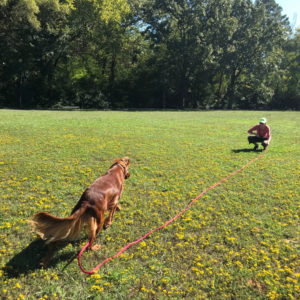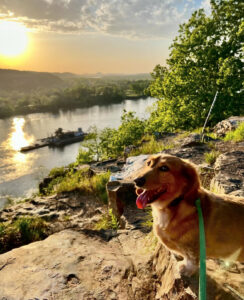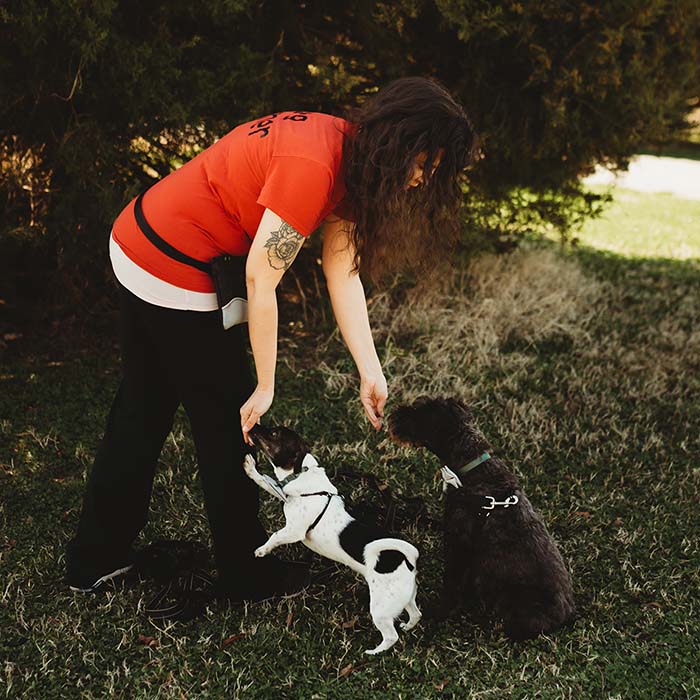Doggy Daycares – The Ugly, The Bad, The Good
Fantasies of a dog utopia can overshadow the reality of what a dog needs
The Ugly
I limped out of the back kennel room, convinced my thigh had been shredded.
An Australian Shepherd had developed aggression directed only at other dogs already kenneled. I liked this dog otherwise. He was easily excitable, but also incredibly smart, and he was fun to be around when his aggression wasn’t triggered. But that day, late in April of 2019, there were two other dogs in that backroom: a large, stocky dog that went over threshold quickly, attacking other dogs in playgroups without warning, and his doggy brother, who helped calm him down. I’d been trying to kennel the Aussie, to give him a break from playgroup, where he followed and yelled at other dogs incessantly, but when we went into the backroom, he started barking at the other two. I used my body to separate him and try to direct him away, not having a slip lead on me, but my leg got in the way, and his teeth sank into me.
I got him into a kennel, and limped out, waiting for the blood to soak through my sweatpants.
It was the first major bite I’d experienced since working at the doggy daycare, but not the only one. The large dog kennelled in the backroom had nipped at my elbow, a Plott Hound had done the same. Those were barely anything at all, just redirected behaviors, actually the direct result of my giving them too much attention in their stressed-out state. No skin was broken, I developed no bruises.
But I knew enough about dog behavior as a trainer to see the results of the stress that the kennel-free doggy daycare was having on the dogs.
Doggy Daycare: Short-term care for dogs outside of the home that allows for interaction between dogs in a playgroup.
Doggy daycares have been around for over 30 years in the United States. The first one opened in 1987 in New York City, and the trend has been steadily increasing since the 1990s. Often, dogs are in one big room, with a handler or two. Sometimes they’re rotated out, with downtime in kennels, which allows daycares to keep staff needs small while increasing the number of dogs. Often, dogs are separated by size: small, medium, and large. If they’re a niche, small daycare, they even separate them by play styles or personalities.
Little Rock has about 13 doggy daycares, often with a combination of boarding, playtime during the day, grooming or baths, and training.
Philadelphia, where I trained as an intern before moving to Little Rock, has over 20, including at least two that focus on small group daycare only.
The more rural part of southern New Jersey, where I lived and also trained on Philly Unleashed’s farm, had one in the Medford area, besides the farm. The farm itself provided some aspect of daycare, but not in the traditional sense of one handler overseeing upwards of 20-30 dogs in a room all day. The farm was structured as a training facility, with two enrichment activities and two training sessions a day. While they boarded dogs and allowed dogs to play, not all dogs could. In fact, the farm started as an opportunity for dogs who didn’t do well in a traditional kennel environment (where there is no enrichment or play, simply some potty breaks) and the doggy daycare/boarding environment (play for sometimes up to 12 hours a day, and no enrichment). A lot of the dogs I handled as an intern there had behavioral issues. Some, as owner Nicole Larocco-Skeehan explained, just want some one-on-one time with a human, either cuddling or playing fetch. It’s a highly catered service that comes with a comparable price tag.
Enrichment: Engaging a dog’s brain with something challenging or fun, depending on what the dog enjoys doing. This can be a puzzle toy, a training session, or a Kong frozen with some pumpkin or peanut butter.
I’d heard, working on the farm, the horror stories of doggy daycares, along with the benefits, especially the small group ones. I had no intention of ever working for one, but when I moved to Little Rock, I started hearing about one in particular. It was kennel free, the only one billed as such in the Little Rock area. The facilities were clean, and the dogs seemed happy, and the people seemed to care. I started working on the floor as a handler, while building a training program for the facility. They’d had trainers before, but they hadn’t lasted long. I didn’t worry too much about that–things happen, and I was finally working with dogs again.
I limped out of the backroom that day, staring at my thigh, waiting for blood to soak through my sweatpants. This is always the risk of working with dogs, but I was careful. Getting bit was not a regular occurrence for me. We’d known there were issues with the Aussie, but I did not feel like management took my comments seriously.
I explained to the manager what had happened, and she asked to see. I pulled up my pant leg, and while I’m worried about what damage the dog did to me, all she could comment on was how hairy my leg was. It’s such a trivial, silly thing to happen in the aftermath trauma of a bite, which is why it stuck out to me. When a bite happens, the adrenaline hits. It happened with the first bite I ever got that left a scar, and it happened with this one–the rush, the fear.
There was no blood. He hadn’t broken skin. It turned into a massive bruise across my thigh that took weeks to heal.
When he shredded a manager a week or so later, breaking skin, they started demanding that he come and leave with a muzzle on.
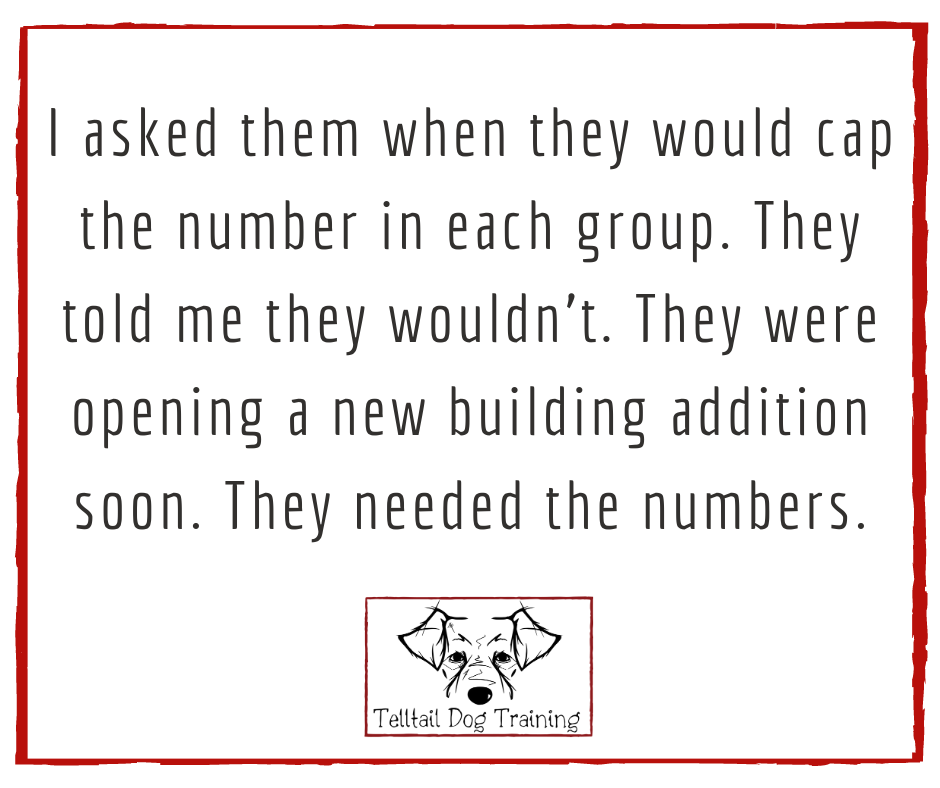
I’d like to say that was an isolated incident with this daycare, but there was more. As it increased in popularity, they started taking in more dogs. I asked them when they would cap the number in each group, as there were only three: small, medium, and large. They told me they wouldn’t. They were opening a new building addition soon, and they needed the numbers to fill the new space. I watched the size of the groups increase.
The Bad
While claiming to be kennel free, staff kennelled dogs without any sort of process for potty breaks, water, or group reintroduction. Shift changes sometimes caused those dogs to be overlooked. Because some people used the doggy daycare for their dogs due to long hours, when dogs started having issues, the staff wouldn’t tell the owners and made it clear to me that they had no intentions of doing so. Instead, they wrote up a list of dogs that had to be kenneled for the majority of the day and pasted it on the wall.
There was also the issue that new staff was not trained, at least when I started. They often shadowed for a day or two and then were left on their own, sometimes with as many as 30 to 40 dogs in one room. This is an exorbitant amount and was difficult for me as a dog trainer with experience. Once I submitted a formal complaint, they started trying to staff rooms more and asking staff to watch videos on dog behavior.
Difficult behaviors from dogs were not addressed. Dogs were often kenneled quickly, without a process, but often these were only the dogs who started fights or were acting up. The quiet dogs, like the Golden sitting in the corner foaming at the mouth due to stress, were not helped. With one or two staff members watching upwards of 60 or more dogs a day, there were simply no resources to make sure each dog was doing all right and getting what she needed.
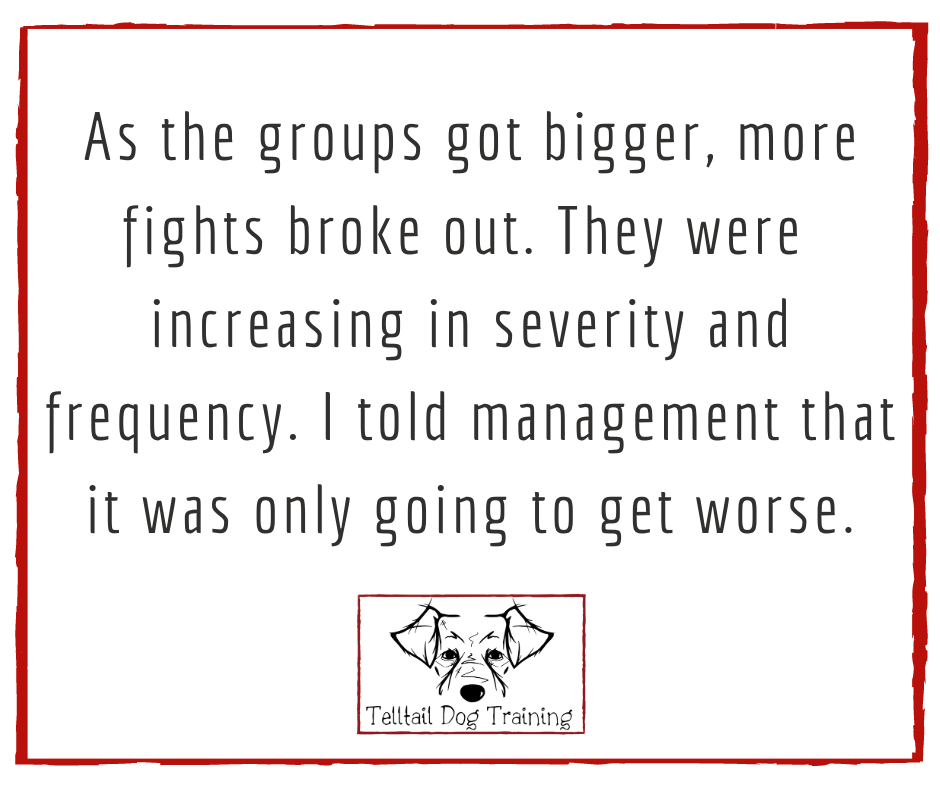
And as the groups got bigger, more fights broke out. They were increasing in severity and frequency. I told management that it was only going to get worse, because they kept cramming dogs in. There was no easement into playgroups either. Dogs, even new ones, were often dragged in, directly into a gang of dogs at the door ready to nip and bark.
I asked to be removed from the floor, declining any further shifts. Ultimately, It was the end of my time there.
The Good
Even with all of that, I still don’t think doggy daycares are a bad idea. I picked up a friend’s dog recently from another doggy daycare, asked them some questions about their methods. My friend’s dog was there for boarding, and they also had playgroups. They would not let a dog join a playgroup until staff got to know the dog. They’d introduce them to dogs slowly. They kept groups small. That, to me, is ideal.
But it’s also difficult to find due to expenses. “It’s a lot of work,” Nicole told me recently. “I looked into doing a daycare, but it’s hard to make it work financially without 80 dogs in the room.”
Ready to Play
Not all dogs are suited for a doggy daycare environment. Some dogs just don’t like other dogs. Some, especially once they reach two years old, aren’t interested in playing anymore. If you’re looking for a doggy daycare just for socialization and not for schedule or energy needs, take a good look at your dog and make sure he really wants to go.
Nicole shared the ideal dog for a doggy daycare:
- People friendly. He should enjoy being around human beings, and believe it or not, not all dogs do! Some just want to be around their owner or their family and would not have a good time interacting with a staff member.
- Dog friendly. Some dogs don’t like other dogs. Some enjoy them, but get excitable and get what trainers call “over threshold”, where they’re so stimulated by sounds, noises, new dogs, and more, that they are unable to function well in a large group setting. These are often the sorts of dogs that attack others without warning, or resource guard something like the water bowl.
- Enjoys playing. Play behavior includes play bowing, a wiggling body, chase games that take turns, and a general interest in interacting with other dogs. The dog who simply walks around, say, the dog park, sniffing things and showing no interest in other dogs, would not be a good candidate for a doggy daycare. The dog with energy, who loves running around and meeting new dogs, is a much better candidate.
- Easy going. Some dogs are unruffled by the world and any perceived slights. They could take a correction and keep going, unbothered. Others are ready to fight immediately. Sometimes these behaviors show up just at daycare, or sometimes a dog is truly unflappable. We’d all like our dogs to be unflappable, but it’s not super common. Our dogs have dislikes, likes, and can get the canine equivalent of, well, road rage.
- Young. A lot of dogs enjoy doggy daycare until they don’t anymore, and the shift often happens when they reach social maturity around age two. Their brains have finished developing and often they don’t enjoy playing as much.
I saw plenty of dogs at the doggy daycare that charged another dog to say hello, stiffly greeting them by shoving their face in the other dog’s face. I called this an inappropriate greeting because in the dog world, it’s rude. Nicole refers to this sort of dog as awkward, and it could be a sign that your dog is anxious. “If they don’t meet dogs with a turnaround and sniff the butt, or they don’t play bow and offer reciprocal play, they might not be a good candidate,” Nicole said.
This is often the sort of dog that feels out of control in the doggy daycare environment and may try to control the smallest things, like the water bowl, or in the case of Porter, Nicole’s dog, a bug. “Sometimes a behavior can show up that doesn’t show up anywhere else,” Nicole explained.
At the time, she was working a 9-5 job, and Porter, her second dog, was just a puppy. She brought him to a doggy daycare, and noticed when she picked him up that he wasn’t with the other dogs. Staff told her he probably needed a nap, and she figured he was tired. But another day, getting off of work early at 1 pm, she noticed he was still on his own. She asked the staff about it, and they were reluctant to say anything. “I told them, ‘I’m a dog trainer, I can handle what you’re going to tell me,’” she said. “They said, ‘Okay, he does this weird thing.’”
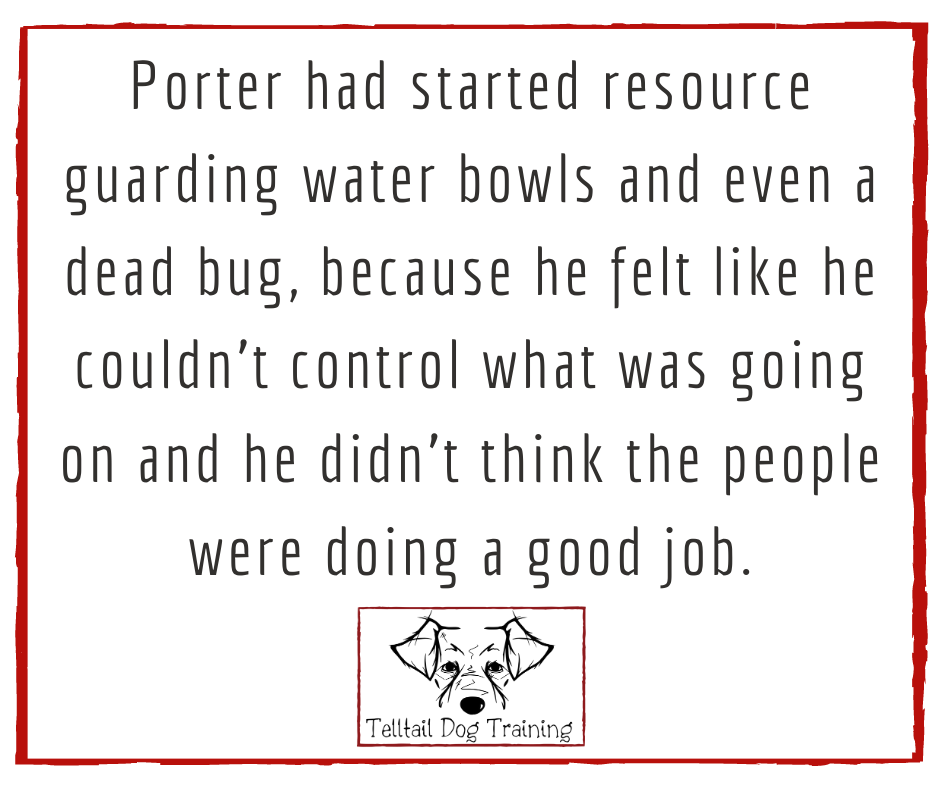
Porter had started resource guarding one thing every day, from the water bowl to a dead bug. “He felt like he couldn’t control what was going on and he didn’t think the people were doing a good job, so he found something to control,” Nicole explained.
It’s not uncommon — some dogs are not aggressive until another dog gets near the thing they’re trying to control, like Porter.
Sometimes it’s the door.
Sometimes dogs truly are just tired, especially if they’re there all day, and it’s too much. Philly Unleashed trainer Kat wrote about this in her last article. Dogs can get fussy and cranky, especially when they’re exhausted. “Dogs don’t need to run for eight hours,” Nicole explained.
But they do need enrichment, regardless of how much they’re running and how much energy they have. It’s tempting to rely on the doggy daycare to keep a high energy dog calm, but if behaviors develop and the dog ultimately gets kicked out, an owner can struggle with how to deal with a dog who needs an energy release. “It’s a vicious cycle,” Nicole explained. “Dog owners can end up using doggy daycare as a crutch, and then the dog gets in trouble and has to leave. The dog can’t live in the home without stimulation. It’s rough for the dog to live with a little less exercise, but they can’t live on no exercise and no enrichment exercises. You’ve got to be that enrichment for them.”
Plus, doggy daycares may be reluctant to share troubling information with clients. “They grow attached to the dog, the owner,” Nicole shared. “Behavior starts subtle, then gets worse. It’s easier to put the dog in a crate and say it needed a nap.”
When a dog isn’t causing trouble but not having a good time, especially as subtle behaviors develop, the doggy daycare is ignoring issues that can lead to much bigger problems–often ones that require a trainer to help solve. This is all while keeping in mind that doggy daycares can struggle to keep staff due to the nature of the job, which isn’t cuddling puppies all day. It’s mostly scooping up poop, which can get tiring for the biggest dog lover, even when all the dogs are having a good time. And when staff is not trained in dog behavior, they’re not noticing the subtle changes or subtle troubling behaviors, like the Golden foaming at the mouth in the corner, the Doodle stealing items to tear up, the Lab mix in the corner eating rocks, or the Boston hiding under the slide. “When staff is not being forthcoming with the owner until serious problems start, they’re doing a disservice,” Nicole shared. “Owners get upset, and feel, ‘If my dog was slamming other dogs four months ago, why didn’t you tell me sooner?’”
As always, I encourage dog owners to make decisions based on education, not fear. There are a lot of reasons why a doggy daycare could be an excellent choice for you and your dog. Advocate for your dog, watch for behavior changes, and ask questions if staff gives you what Nicole calls the dreaded response: “He’s fine.”
Next week: Kids and dogs! We step into memories of my family’s dog, Sheba, and my attempts to train her when I was 11 years old. I’ll share what ages seem to do best with training (although there is always individual consideration), and how neglectful situations can impact both children and dogs.
Group classes take place every Saturday at SoMa Animal Clinic. I also offer private in-home lessons in the Little Rock area and training walks for current clients. Email me at info@telltaildogtraining.com for more information.

